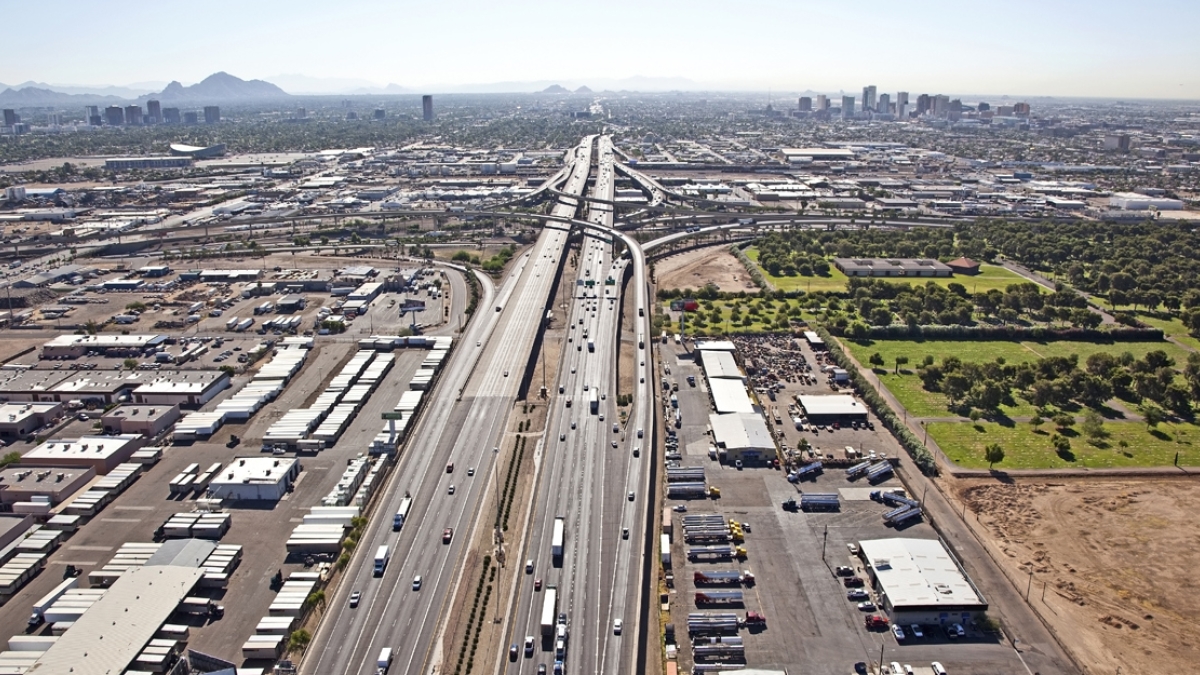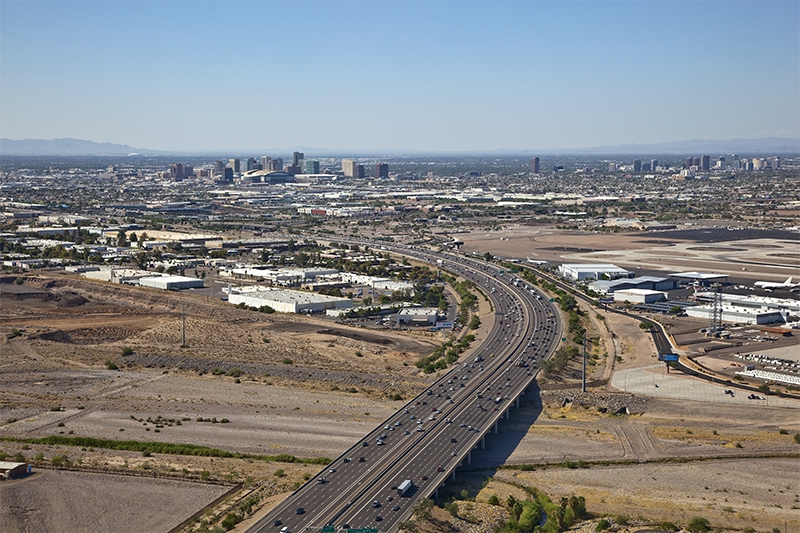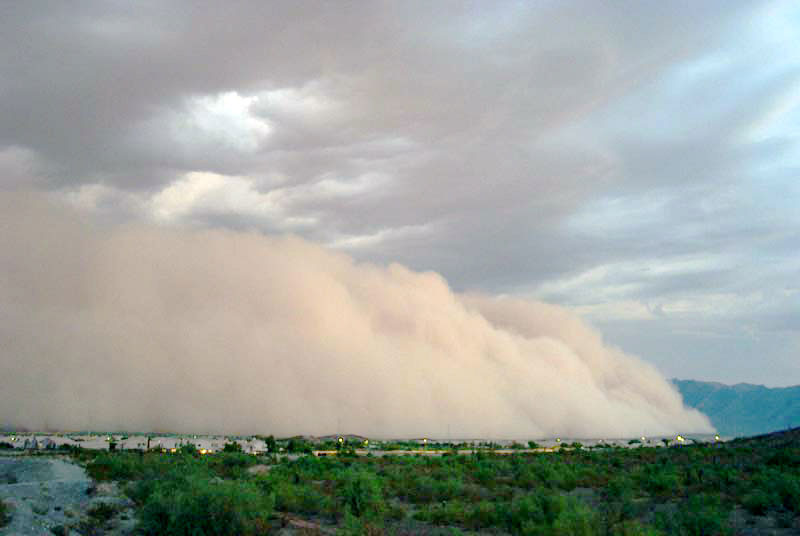Stretching across the southernmost U.S. states, Interstate 10 is an east-west artery connecting people, cities and economies from sea to shining sea. It glimpses palm trees near the Pacific Ocean in Santa Monica, California, NASA Mission Control in Houston and the Atlantic Ocean in Jacksonville, Florida.
In Arizona, I-10 is a conduit between the cities of Phoenix, Casa Grande and Tucson. Together these metropolitan areas function as a growing southwest megaregion. Cities within a megaregion are tied together by strong links and can influence one another, even if they're hundreds of miles apart.
One of these connections is freight traffic, a material expression of the economy and a key dynamic within and between megaregions. Every day, trucks on I-10 carry the stuff of our livelihoods — from avocados to Ziploc bags — through Arizona and beyond. Along the way, they put significant wear and tear on the interstate, create demand for infrastructure, including rest stops and fuel stations, and affect driver safety. Changes in vehicle technology and fuel, as well as changes in the climate, are poised to affect freight traffic, interstate safety, infrastructure and economies.
A team of researchers from Arizona State University, the University of Arizona and Northern Arizona University are thinking ahead of these changes with a series of projects that will plan for the future of freight traffic on I-10 through Arizona with a focus on efficiency, safety and sustainability.
“Hopefully, in the long run, this research will help shorten commutes, save lives, create more breathable air and find a way to pay for all of it,” said Michael Kuby, a professor in ASU’s School of Geographical Sciences and Urban Planning.
Kuby is one of the three principal investigators on the project, along with Larry Head, a professor in the Department of Systems and Industrial Engineering at UA, and Edward Smaglik, associate professor in the Department of Civil Engineering, Construction Management and Environmental Engineering at NAU.
Recognized for its potential to improve Arizona livelihoods and the economy, the project was awarded a Regent Innovation Funds (RIF) grant from the Arizona Board of Regents. The RIF I-10 project complements an Arizona Department of Transportation (ADOT) project in conjunction with Texas, New Mexico and California DOTs.
"I'm hoping that by taking this different look at the corridor that we can contribute to the greater good of ADOT and what they are trying to accomplish," Head said.
Just passing through
Freight trucks are especially tough on roads, and they roll through Arizona continuously. Most of these trucks do not start or end their hauls in Arizona, but simply trundle on through between Texas and California.
“We're a pass-through state,” Head said. “The number of vehicles is pretty uniform over all time and all ways traveling through the state. In Phoenix and Tucson, you see bumps in the number of vehicles on the road based upon time of day, but with the freight trucks it's just a steady stream of about the same number of trucks all the time.”
Arizona bears the wear and tear, traffic, emissions and safety hazards associated with these big rigs, while the origin and destination states generate more of the jobs in logistics and manufacturing. One team is looking at ways Arizona can reap more benefits from this pass-through traffic. States recoup some of the wear and tear costs and pay for new infrastructure through several types of taxes. Notably, this occurs through fuel tax but also through sales tax and property tax. For diesel fuel used by trucks, an interstate compact ensures that each state receives its fair share of fuel taxes proportional to miles driven in each state regardless of where the fuel was purchased.
In most other ways, however, the benefits of the pass-through freight are hard to identify. Pass-through trucks don’t produce many jobs in-state, and existing taxes don’t address these trucking activities. For instance, sales tax is incurred only when the goods are offloaded and sold in the state. Property tax revenues may rise where improved transportation generates higher demand for land accessible to the infrastructure, but pass-through traffic generates little business en route. In addition, Arizona is one of a handful of states that don’t allow “tax-increment” financing based on anticipated future property tax increases.
The researchers see the RIF I-10 project as an opportunity to explore alternatives, including economic opportunities for the state. They will collaborate on an overall concept plan for the I-10 Arizona corridor as well as on six additional projects. These will focus on economic impact, infrastructure resilience, safety, weather prediction and warning, alternative fuels, and education.
From driverless trucks to haboobs
One project will evaluate an emerging technology called connected and automated vehicles (CAVs). Freight trucks operating as CAVs will be connected wirelessly, moving as a caravan with minimal space between them and operated by a single driver — or, perhaps one day, no driver at all. This technology has the potential to increase the efficiency at which freight trucks move along I-10 and would likely improve safety. A safer I-10 is something that could affect Head personally.
"Being in Tucson, I come to Phoenix at least once a week. It scares me. There are a lot of freight vehicles out there," Head said.
The team will simulate how a mix of connected and unconnected vehicles sharing the road will affect the quality of real-time traffic data. What if cars and trucks share all lanes of I-10, but only the trucks are equipped for connectivity? What if there’s a designated lane for trucks, but only some of the trucks are communicating? The simulations will help traffic engineers figure out how best to deal with partial information during the gradual transition to CAV trucks.
Another project will identify threats posed to transportation infrastructure by natural and man-made hazards. The team will then develop a framework for evaluating and selecting strategies for mitigating the harmful effects of these threats. With a better understanding of these issues, CAVs can be designed to ensure reliable, safe and efficient service under the extreme and variable climate conditions we are likely to face in the coming decades.
Dust storms are a common weather hazard in the Arizona desert. They can change roadway conditions from safe to threatening in the time it takes you to say “haboob.” But comprehensive data about the timing and location of dust storms do not exist.
To address this, the team is examining different data sources to develop a dust storm climatology and pinpoint locations along the roadway that are associated with higher risk. In parallel, researchers at UA and NAU are using sophisticated computer models to simulate the complex dynamics that control the formation and movement of dust storms. Ultimately, the teams will use this information to contribute to state and regional discussions about weather safety measures such as smart alerting systems and variable speed limits.
Alternative-fuel chicken and egg
One of the projects could help the alternative vehicle and fuel “chicken and egg” problem, as Kuby describes it. Currently, car and truck manufacturers are reluctant to ramp up production of alternative fuel vehicles due to a lack of fueling stations. Meanwhile, energy companies delay building alternative fuel stations because the vehicles that need them are such a small market share. Chicken, meet egg.
“You’ve got to break that cycle somehow,” Kuby said. “Lack of refueling stations is the No. 1 barrier to transitioning away from petroleum-based fuels."
To overcome this barrier, the team is thinking outside the usual planning methods and using a new “geo-design” approach for natural gas fuel stations. This alternative fuel is in the lead to be the future energy for freight trucks.
A geo-design approach is considered bottom-up because stakeholders are involved in the planning. The project team is building a geographic information systems (GIS) platform that will enable industry and government stakeholders to visualize related information, move stations around on a digital map, evaluate how well their deployment plan performs on several metrics and compare their plans with those of other groups. Geo-design has been pioneered successfully in recent years for land management, but this is the first time it will be applied to facility location.
In addition to the planning approaches of the project team for the I-10 corridor, the collaboration itself is innovative. Experts across fields and universities are coming together with stakeholders like ADOT and the freight industry in the first large-scale transportation project of its kind in the state. It is fitting to bring together such a diverse group, Kuby said, because transportation is by definition interdisciplinary.
“This is the first time," said Smaglik, of NAU, "we have a project between all of us, and you can see relationships and partnerships develop as we work through this. It’s going to be very exciting and very fruitful as we move into the future.”
Additional ASU faculty working on the RIF I-10 project include:
- Mikhail Chester, assistant professor, School of Sustainable Engineering and the Built Environment
- Randall Cerveny, President’s Professor, School of Geographical Sciences and Urban Planning
- John Fowler, Motorola Professor of International Business, W. P. Carey School of Business
- David Hondula, assistant professor, School of Geographical Sciences and Urban Planning
- David King, assistant professor, School of Geographical Sciences and Urban Planning
- Yingyan Lou, assistant professor, School of Sustainable Engineering and the Built Environment
- Arnie Maltz, associate professor, W. P. Carey School of Business
- Deborah Salon, assistant professor, School of Geographical Sciences and Urban Planning
- Shane Underwood, assistant professor, School of Sustainable Engineering and the Built Environment
Postdoctoral students working on the RIF I-10 project include:
- Samuel Markolf, Julie Ann Wrigley Global Institute of Sustainability
- Fangwu Wei, School of Geographical Sciences and Urban Planning
RIF grants are funded through the Technology Research Initiative Fund, a voter-approved sales tax to fund K–12, community college and public university education and research. The Arizona Board of Regents manages the distribution of TRIF funds to the state universities.
More Science and technology

Applying AI to microelectronics manufacturing
Rivers flow across the planet’s surface, carving deep valleys and intricate canyons. Likewise, makers of microelectronics direct plasma, an ionized gas, to travel over silicon wafers, etching…

Applied Materials invests in ASU to advance technology for a brighter future
For nearly 60 years, global giant Applied Materials has been hard at work engineering technology that continues to change how microchips are made.Their products power everything from flat-panel…

Meet ASU engineering students who are improving health care, computing and more
Furthering knowledge of water resource management, increasing the efficiency of manufacturing point-of-care health diagnostic tools and exploring new uses for emerging computer memory are just some…




